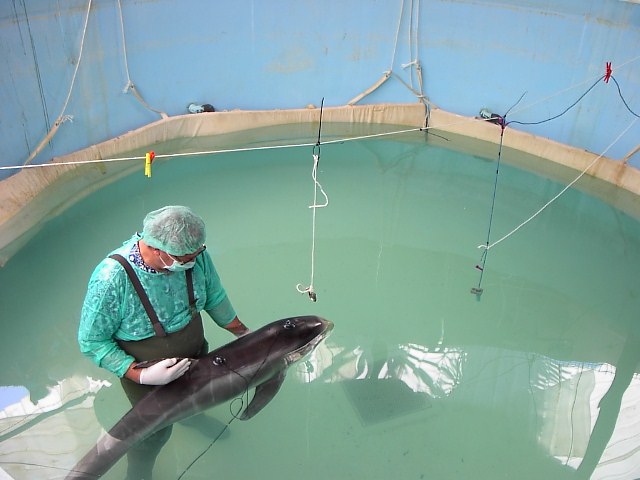Paul E. Nachtigall - nachtiga@hawaii.edu
Michelle Yuen, T.Aran Mooney and Kristen Taylor
University of Hawaii, Hawaii Institute of Marine Biology
Popular version of paper 2pAB4
Presented Tuesday afternoon, November 16, 2004
148th ASA Meeting, San Diego, CA
A baby Risso's dolphin, a species found in warm temperate and tropical waters, was stranded on a beach in Southern Portugal and taken to the rehabilitation center at 'Zoomarine' oceanographic theme park in Portugal. Members of four other dolphin species had also stranded within two weeks and the baby seemed to be "listing," or lying to one side. Elio Vicente, the director of the Rehabilitation Center at Zoomarine, called us and asked if it would be possible for us to come test the hearing of this infant dolphin. Dolphins are folded in two prior to birth and are born with fetal fold marks. This baby dolphin was so young its fetal folds were obviously present.

There has been a great deal of concern lately about the effects of loud sound
on marine mammals, including recent strandings and deaths of animals following
exposure to loud sounds. Frequently the only subsequent evidence is massive
physical trauma to the ears. Here we had the opportunity to diagnostically examine
the hearing of an infant dolphin that may, or may not have been, over-exposed
to sound. Using an "Auditory Evoked Potential" (AEP) procedure to
gently pick up the brainwave patterns of the baby through human EEG sensors
embedded in soft rubber suction cups (placed on the skin surface), we were able
to pick up the animal's responses to the specially prepared pure tones that
we played - the tones were "amplitude modulated" or fluctuated in
their loudness--and therefore we could test its hearing. because the dolphin's
brainwave patterns follow the amplitude modulations of our sounds. Similar procedures
are currently used to test the hearing of human babies.
Sounds easily heard by the animals produce large brainwaves that follow the
amplitude modulation rate of the pure tone that is played while quiet sounds
that the animal just barely hears produce small brainwaves.


To our knowledge, this is the first time that an infant marine mammal's hearing
has been measured. Only one Risso's dolphin, an older female, had previously
been audiometrically examined and it was generally believed that Risso's dolphins
only heard up to 100 kHz - a very high frequency, but not nearly as high as
normal young bottlenosed dolphins that hear up to 150 kHz. This baby Risso's
dolphin 'rewrote the book' on Risso's dolphin hearing. It heard extremely well
and it heard frequencies up to 150 kHz - just like a young bottlenosed dolphin.
Its hearing had apparently not been damaged. We were very fortunate to accomplish
at least three things with this work.
1. We demonstrated that, as is done with human babies, we could also test the hearing of dolphin babies.
2. This dolphin's hearing had not been damaged. It heard extremely well.
3. The opportunity to get on an airplane and go to a rehabilitation site to quickly see whether an animal has had its hearing damaged is very reasonable thing to do.
We hope to expand our efforts to study the hearing of stranded dolphins and
whales.
When dolphins and whales strand it is important to know whether they stranded
because of some hearing difficulty. Overexposure to loud sound can cause hearing
deficits and deaf animals, if successfully rehabilitated and subsequently released,
may have difficulty surviving in the wild.. Also, there are over 85 species
of dolphins and whales and we have hearing measures on only 11 of those species.
Each new animal, and each new species, examined presents an opportunity to know
more about the hearing of dolphins and whales. The more we know about the hearing
of these animals, the more we can do to protect them.